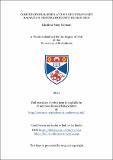Files in this item
Computational simulations of ultraviolet radiation penetration into human skin
Item metadata
| dc.contributor.advisor | Brown, C. Tom A. | |
| dc.contributor.advisor | Wood, Kenny | |
| dc.contributor.author | Barnard, Isla Rose Mary | |
| dc.coverage.spatial | xxv, 144 p. | en_US |
| dc.date.accessioned | 2021-11-30T11:45:55Z | |
| dc.date.available | 2021-11-30T11:45:55Z | |
| dc.date.issued | 2021-11-30 | |
| dc.identifier.uri | https://hdl.handle.net/10023/24440 | |
| dc.description.abstract | This thesis concerns the development of numerical modelling simulations to predict how ultraviolet radiation (UVR) penetrates into human skin in a wavelength dependent manner. UVR has biological effects; for example, UVR causes damage to DNA within skin cells, and these effects are wavelength dependent. A Monte Carlo Radiative Transfer (MCRT) model was developed in order to simulate the transport of UVR from different radiation sources through the upper layers of human skin. Using the results of these simulations, the depth to which different wavelengths of UVR penetrate can be examined, and then resulting biological effects can be predicted. The research presented here quantifies DNA damage occurring due to sunbed use, investigates the protective effects of melanin and sunscreen, investigates potential novel lamps for psoriasis treatment and examines the safety of UVR sterilisation devices. In addition, research is presented from practical work, evaluating the performance of a handheld UVR meter when used to measure UVR output from commercial sunbeds. | en_US |
| dc.description.sponsorship | "This work was supported by an UK EPRSC PhD studentship [EP/N509759/1] and MediLase, the Medical Laser Research Fund (Registered Charity SC037390)." -- Funding | en |
| dc.language.iso | en | en_US |
| dc.publisher | University of St Andrews | |
| dc.subject | Monte Carlo radiation transfer | en_US |
| dc.subject | Photobiology | en_US |
| dc.subject | Ultraviolet radiation | en_US |
| dc.title | Computational simulations of ultraviolet radiation penetration into human skin | en_US |
| dc.type | Thesis | en_US |
| dc.contributor.sponsor | Engineering and Physical Sciences Research Council (EPSRC) | en_US |
| dc.contributor.sponsor | Medical Laser Research Fund (Medi-Lase) | en_US |
| dc.type.qualificationlevel | Doctoral | en_US |
| dc.type.qualificationname | PhD Doctor of Philosophy | en_US |
| dc.publisher.institution | The University of St Andrews | en_US |
| dc.publisher.department | Photobiology Unit, Ninewells Hospital and Medical School, Dundee | en_US |
| dc.identifier.doi | https://doi.org/10.17630/sta/150 | |
| dc.identifier.grantnumber | EP/N509759/1 | en_US |
This item appears in the following Collection(s)
Items in the St Andrews Research Repository are protected by copyright, with all rights reserved, unless otherwise indicated.

